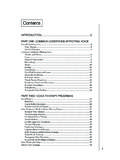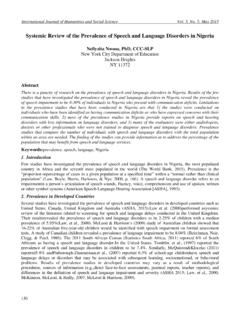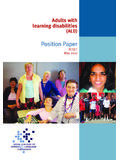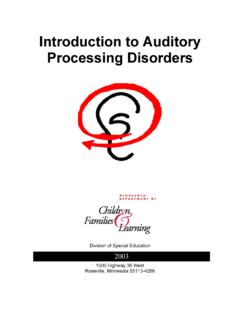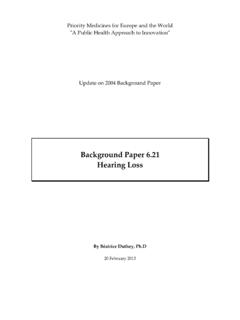Transcription of Speech treatment for - National Center for Voice …
1 Author Proof 2008 Future Drugs LtdISSN treatment for Parkinson s diseaseExpert Rev. Neurotherapeutics 8(2), 299 311 (2008)Lorraine O Ramig , Cynthia Fox and Shimon Sapir Author for correspondenceDepartment of Speech , Language, Hearing Sciences, University of Colorado, Boulder, Campus Box 409, Boulder, CO 80309, USATel.: +1 303 492 3023 Fax: +1 303 499 estimate that 89% of people with Parkinson s disease (PD) have Speech and voicedisorders including disorders of laryngeal, respiratory and articulatory function. Despite thehigh incidence of Speech and Voice impairment, studies suggest that only 3 4% of peoplewith PD receive Speech treatment . Here, we review the literature on the characteristics andfeatures of Speech and Voice disorders in people with PD and the types of treatmenttechniques available (medical, surgical and behavioral), with a focus on behavioral provide a summary of the current status of the field of Speech treatment in PD andrecommendations for implementation of the current efficacy of treatment for future research, including a speculative viewpoint on how the field will evolve in5 years time, are.
2 Dysarthria hypokinetic hypophonia LSVT neural plasticity Parkinson s disease Speech and Voice disorder Speech and Voice treatmentOral communication is vital in education,employment, social functioning and self-expres-sion. The prevalence of disordered communica-tion is particularly high (89%) in the nearlyseven million individuals worldwide with Par-kinson s disease (PD); however, only 3 4%receive Speech treatment [1 3]. Soft Voice , mono-tone, breathiness, hoarse Voice quality andimprecise articulation, together with lessenedfacial expression (masked faces), contribute tolimitations in communication in the vast major-ity of individuals with PD [4,5].
3 The reducedability to communicate is considered to be oneof the most difficult aspects of PD by manypeople with the disease and their families [6].Moreover, Speech and language changes in PDcan have a negative impact upon individualswith PD and their family-life long before frankimpairments of intelligibility are apparent [7].Affected individuals often become disabled orretire early, are forced to give up activities theyenjoy, incur substantial medical costs and haveincreased mortality [8 10]. Based upon 2004 esti-mates, PD costs the USA US$34 billion annu-ally in direct health-related expenses, disability-related costs, and lost productivity [11,12].
4 As thenumber of elderly people greater than 65 yearsof age increases, these costs are expected toexceed US$50 billion by 2040 [13]. The averageage of diagnosis of PD is 60 years, but in manyindividuals the disease develops at a muchyounger age. Given the relative slow progressionof the disease, improvement in the ability ofthese individuals to communicate increases thechance that they could maintain an improved,productive quality of life, despite living out therest of their life with a chronic disease. Thus, thevalue of an effective treatment for disorderedcommunication in this population is clear. Although medical treatments, including neu-ropharmacological as well as neurosurgicalmethods, may be effective in improving limbsymptoms, their impact on Speech productionremains unclear [14 20].
5 Moreover, historically,people with PD have been particularly resistantto Speech treatment [1,21 26]. Recently, however,a Speech treatment approach called Lee Silver-man Voice treatment (LSVT LOUD) has gen-erated efficacy data for successfully treating voiceand Speech disorders in this population. Thepurpose of this review is to: Provide a brief summary of Speech and voicecharacteristics associated with PD Discuss medical and behavioral Speech treat-ment approaches for PD Summarize key components of Speech treat-ment that seem to underlie positive outcomes Highlight ongoing and future research direc-tions in Speech treatment for PD Author Proof 300 Expert Rev.
6 Neurotherapeutics 8(2), (2008)Review Ramig, Fox and SapirSpeech & Voice characteristics in PDDisorders of laryngeal, respiratory and articulatory functionhave been documented across a number of perceptual, acousticand physiological studies in people with PD [27 33]. The neuralmechanisms underlying these Voice and Speech disorders areunclear [34 39]. Traditionally, they have been attributed to motorsigns of the disease such as rigidity, bradykinesia, hypokinesiaand tremor. Of particular importance to Speech and Voice disor-ders in people with PD are the proposed pathophysiologicalmechanisms underlying bradykinesia/hypokinesia: inadequatemuscle activation [40]. The muscle activation deficits that occurin bradykinesia are believed to result from inadequate mergingof kinesthetic feedback, motor output and context feedbackwithin the basal ganglia, that is necessary to select and reinforcean appropriate gain in the motor command [40,41].
7 This is sup-ported by single cell recording studies [42] and recent brain acti-vation imaging studies [41] showing a correlation in activation ofneurons or muscle with increasing movement amplitude. Inaddition to the mechanisms of bradykinesia/hypokinesia,abnormal sensory processing [43 45] and impaired ability to initi-ate a motor response (problem with internal cueing) [46,47] playan important role in Speech and Voice , Speech and Voice in people with PD are charac-terized by reduced loudness, monopitch, monoloudness,reduced stress, breathy, hoarse Voice quality, imprecise articula-tion, short rushes of Speech , and hesitant and dysfluent Speech [48,49].
8 Collectively, these Speech symptoms are called hypokineticdysarthria [50]. Voice problems are typically the first to occur,with other problems, such as prosody, articulation and fluency,gradually appearing as the Speech disorder progresses [2,3,45].Acoustic descriptions of Voice characteristics of people withPD have also been documented. Early studies varied in report-ing a reduction in vocal sound pressure level (vocSPL) in thesepeople [51 55]. More recently, Fox and Ramig compared 29 peo-ple with PD with age- and gender-matched neurologicallyhealthy individuals (control group) and found that vocSPL was2 4 decibels (at 30 cm) lower across a number of Speech tasksin the people with PD relative to the control group [6].
9 A 2 4decibel change is equal to a 40% perceptual change in loudness[6]. In addition to an overall low level of vocal loudness, Ho andcolleagues found that Voice intensity in people with PD tend todecay much faster than that observed in a control group duringvarious Speech tasks [56]. Results related to the Voice frequency(an acoustic correlate of pitch) in the Speech of people with PDhave consistently reported a reduced frequency range[51 53,54 57]. These findings support the perceptual characteris-tics of monopitch or monotonous Speech typically observed inthis patient population [3,48 49,58]. Acoustic correlates of disor-dered articulation have been studied and include problemswith timing of vocal onsets and offsets (voicing during nor-mally voiceless closure intervals of voiceless stops), reducedrange of vowel articulation [59] and spirantization (presence offricative-like, aperiodic noise during stop closures) [34,60,61].
10 Physiologic abnormalities associated with Speech & Voice disorders in PDPhysiologic (videolaryngostroboscopic and electroglot-tographic) studies of Voice in people with PD have documentedvoice tremor, poor vocal fold closure and reduced amplitude,asymmetry or slow vibratory patterns of the vocal folds [62,63].Respiratory studies in people with PD have documented reduc-tion or abnormalities in vital capacity, amount of air expendedduring maximum phonation tasks, intraoral air pressure duringconsonant/vowel productions, chest wall movements and respi-ratory muscle activation patterns during Speech breathing [64].Electromyographic (EMG) studies of vocal function in peoplewith PD indicate either a reduction of neural drive to the laryn-geal muscles [27] or abnormally elevated laryngeal muscle activ-ity [65], and poor reciprocal suppression of laryngeal and respi-ratory muscles [66].

